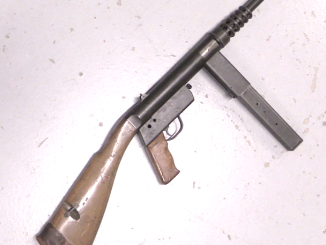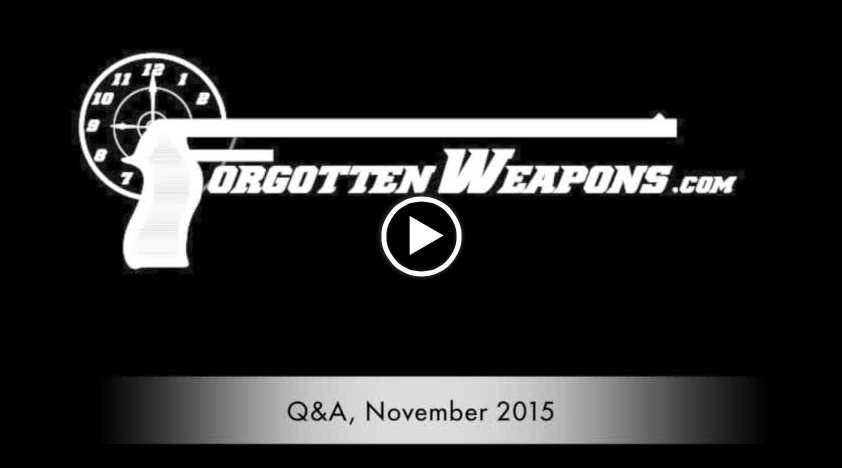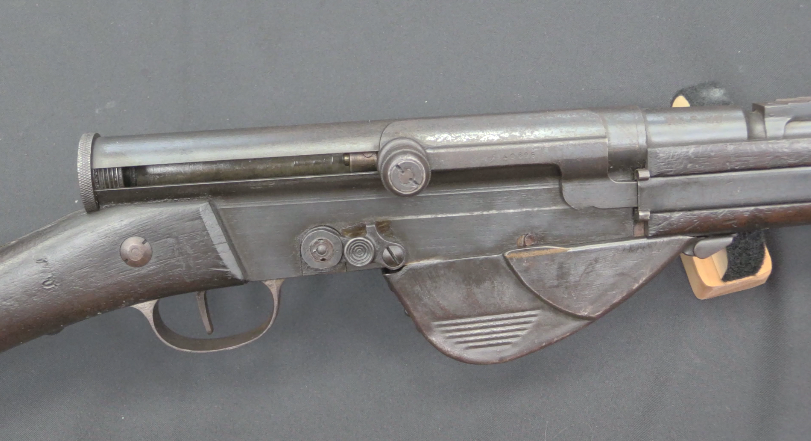Today I am out at the range to put the first shots through a completed replica of the French Chauchat-magazine Berthier conversion. The real versions of these guns were made on Mle 1890 cavalry carbines and Mle 1907-15 long rifles, as survival rifles for pilots and observers (fixed wing and balloon) early in World War One. This example was built up from parts and based on an M16 Carbine (with the upper handguard).
I was hoping to be able to use this in a competitive environment to compare it to a Mauser 98 or Springfield 1903 with an extended trench magazine, but it doesn’t look like that will be possible, unfortunately.




It’s a shame it did not work, as this handy carbine with an 18 round magazine would have been a great trench weapon. I must say the idea of a survival rifle for pilots strikes me as being a tad optimistic, given that parachutes were not issued during WWI.
WWI aircraft were so light, had so much wing surface area relative to mass, and generally faced non-explosive projectiles, so they were sometimes able to glide to safety.
That makes the choice of magazine all the more bizarre, though. Aircrew survival weapons in the 50s and 60s strongly prioritized light weight over performance, even though the aircraft had tens of thousands of pounds of thrust. Most everything that went into a WWI plane followed the same philosophy, since they had engines most Americans today would regard as underpowered for compact cars! It’s strange to think they regarded this giant mag as appropriate in that context.
“(…)parachutes were not issued during WWI.(…)”
German aviators were issued HEINECKE during later part of war, see drawing here:
https://www.historynet.com/heinecke-parachute-a-leap-of-faith-for-wwi-german-airmen.htm
it was not easiest to use and have around two-thirds chance to work as intended.
Parachute working in manner similar to modern one was popularized by IRVIN https://en.wikipedia.org/wiki/Leslie_L._Irvin
after that war.
“(…)being a tad optimistic(…)”
Keep in mind that successful crash landing commenced during Great War.
Perhaps one of the reason the Chauchat was long recoil operated is that this system absorbs a lot of the recoil and prevent magazine problems.
Well thinking twice I would says “a part of” the recoil.
I choose to differ. What is happening in long recoil system is that relatively low mass (let’s say about half of mass of gun) is moving at considerable velocity, therefore a source of kinetic energy. This energy has to be dealt with at the end of stroke and operator will receive input into his shoulder as a result. A way around is to arrange for a buffing method which will deal with this energy, such as by using hydraulic shock absorber. That entails complexity with necessity to seal internal liquid reliably. Once the liquid is gone, there is no buffing effect.
As that mass is travelling between two opposed springs some of the egergy is trasnmitted over time.
“(…)Chauchat was long recoil operated is that this system absorbs a lot of the recoil and prevent magazine problems.”
It must be noted that Chauchat featured low Rate-of-Fire for weapon of its time, according to https://modernfirearms.net/en/machineguns/france-machineguns/chauchat-csrg-m1915-eng/
it was 240 round per minute. For comparison – Lewis 550, Hotchkiss Portative 500.
This means magazine has more time to properly position next cartridge.
The rounds in the magazine appeared to shift down on recoil before returning under spring pressure. This would be due to the curve in the magazine, where the rounds lower in the magazine are actually moving *forward* under inertia due to their orientation. This would result in the rounds bouncing up and down in magazine, and slamming into the feed lips as they return.
A high speed video might show this more clearly. This might be an interesting aspect to examine with respect to problems with the highly curved Chauchat magazine.
Thanks for showing us why it’s a bad idea to use a Chauchat magazine in a bolt-action carbine. I suspect the French also found out the hard way. Recoil is a total pain in the rear when the selected weapon kicks harder than the one for which the magazine was designed.
Are there surviving British high capacity rifle magazines or were they all destroyed for other weapon development?
That would make a proper alternative for this concept…
Those antique Chauchat magazines surely add another layer of potential failure. Wroth trying with a few different examples?
What does the “survival weapons” have to do with it?
There were many tigers in the forests of France? 😉
Before the start of the use of machine guns in aviation, the crews had no choice. They took with them everything that could be useful. Starting with extendmag auto-pistols and ending with shotguns. Self-loading rifles were preferred, but there were too few.
Therefore, as a weapon of observers, they used short rifles with large “assault” mags. So did all parties to the conflict (who had aviation). For example, the Americans ordered about a thousand such transformations for the rifle 03, but they (as usual) were late and were unlikely to see serious use in battle.
Tigers in grey. The rifles, like the U. S. air service 1903, were for survival, evasion, resistance, and escape if shot down behind Geman lines or in no man’s land.
I heard french forests are full of feral children :-)))
Frank Luke could have used one of those, if it had worked as intended. Of course he was already wounded when he crash landed.
Well yes. Shooting for survival.
Something like this.
https://image.shutterstock.com/image-illustration/british-twoseater-monoplane-fires-on-600w-248212081.jpg
Do you have a different Google system?
https://today-in-wwi.tumblr.com/post/175307627898/first-successful-use-of-a-parachute-in-combat
Even if the pilot had a parachute, leave the plane with a rifle in his hands …
It’s better to jump out without a parachute at all.
At least it won’t hurt. LOL
Hats of to Mark Novak for his attempt to make a Berthier work with a Chauchat magazine. There is only so much you can do with 100+ year old weapons and magazines.
It’s Frankencarbine !
“It’s Frankencarbine!”(С)
Aviators of those years were entirely non-poor athletes, enthusiasts and adventurers.
Just as all aircraft were “experimental models”, so the armament for them was composed by mechanics involved in the repair (which were often also crew members).
It is only natural that someone came up with the idea to build something suitable from the existing trash.
This was done both in WW2 and in Vietnam era and, possibly, still, in some places.
It’s Frankencarbine ! Fiddling with the magazine in flight is dangerous….people tend to forget to fly the airplane. BTW, how about ten C96 Mausers ganged together….https://www.bing.com/images/search?view=detailV2&ccid=fc4OGy9G&id=52273466AF0A0B30FFBE2ECDF05D454C00D4382D&thid=OIP.fc4OGy9Gv_rPIMi3oKT9kQHaHY&mediaurl=https%3a%2f%2fs-media-cache-ak0.pinimg.com%2f736x%2fac%2f69%2fdc%2fac69dc91b3d642b104bc128cb93b801a.jpg&exph=498&expw=500&q=aircraft+gun+ww1&simid=607992963211134218&ck=0766D48D9E71C025C7A69B6560301E7D&selectedIndex=61&ajaxhist=0
“(…)ten C96 Mausers ganged together(…)”
Air warfare of early part of Great War seen even uncommon weapons used, including grappling hook (deployed by A.A.Kosakoff)
http://www.theaerodrome.com/aces/russia/kozakov.php
I feel pity for the operator. He must have received one hell-of-a crack into his ears.
Not sure if this image url will post, but Ian needs some of these:
https://i.redd.it/lcj48j3p8t451.jpg
Ian, cheers to you and Mark for trying this. Otherwise we all would’ve wondered if the Germans could’ve been defeated by 1917 if only the French had issued 18 round mags. And thanks to you two, now we know.
See! There ARE worse weapons than the Chauchat!
By the way
https://laststandonzombieisland.files.wordpress.com/2018/06/two-m3-grease-gun-smg-submachine-guns-mounted-to-a-cessna-o-1-bird-dog-for-suppressing-fire-vietnam-2.jpg
Hi, thanks for sharing this! Great post! I’ve been trying to familiarize myself with these sorts of things. This is why I came to this site. Usually, I would just go look for games to download on my PC but sometimes I find these sorts of things. Speaking of games, you should try out the creative destruction game. I loved playing this game. You should also try out roblox pc . These two games have been my favorites to play during the quarantine. Super fun and unique. Would definitely recommend them.
There’s an original on display in the Musée de l’Armée in Paris. I saw it today. The museum is well worth a visit it has a huge collection including multiple Fg42 of both types, dual magazine MP40, and all sorts of other goodies you’ll likely see nowhere else, certainly not in one place.